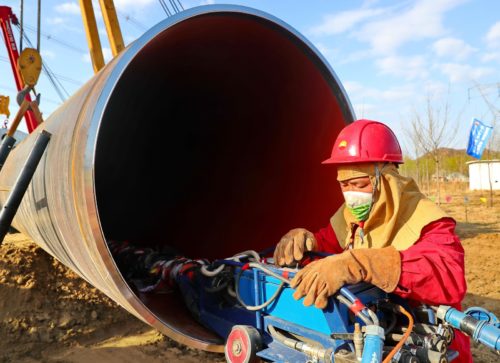China’s superpower ambition faces energy, water supply constraints

Part 1. China’s declining energy, water self-sufficiency
In its drive to become the world’s leading superpower, China has set its sights on developing and controlling artificial intelligence, 5G networks, and robotics. But recent events suggest that the country faces a more pressing challenge in the less glamorous business of securing oil, gas, and water supplies.
On September 14, drone attacks on Saudi Arabia — allegedly undertaken by pro-Iran militia groups — briefly took out more than half of the kingdom’s oil production. It was followed by the U.S. government’s decision to impose trade sanctions on Chinese firms for shipping Iranian oil. In Asia, the Philippines and Vietnam have both solicited Russian support in their battle against China’s aggressive territorial claims, and have put China on the defensive when it comes to oil and gas rights in the South China Sea.
Piling it on, the International Energy Agency (IEA) issued a forecast that China’s natural gas consumption will grow at nearly twice the rate of Beijing’s projections. This came three months after the government of President Xí Jìnpíng 习近平 took the gamble to impose a 25 percent tariff on liquefied natural gas (LNG) imports from the United States starting June 1.
Just before the world held its first Global Climate Strike in late September, a water research group released two reports about China’s worsening environmental and water crises in the Greater Bay Area, encompassing Hong Kong and southern China, and the major economic belt along the Yangtze River. The China Water Risk group opined that water shortages and environmental issues pose a far greater threat to the future of two of the country’s most important economic regions than the headline-grabbing protests now rocking Hong Kong.
The common theme emerging from these disparate events and reports is that China faces a protracted and increasingly difficult struggle to secure energy and water supplies to feed its insatiable appetite. From having to sustain a population over four times that of America’s 330 million, China is already at a severe disadvantage against the world’s incumbent superpower. China has only a portion of the U.S.’s oil, gas, and water resources, and that gap in self-sufficiency is likely to widen further.
The numbers
According to BP’s latest statistical review of world energy, China had 25.9 billion barrels of proven oil reserves at the end of 2018. This was sufficient to meet just more than 30 months of domestic consumption, which is still growing rapidly after reaching a record of more than 13.5 million barrels per day (b/d) in 2018.
With 18 percent of the world’s population and an economy still growing at 5 to 6 percent per year, China has only 1.5 percent of its oil reserves.
These reserves have barely grown over the past five years while domestic production has declined. At the same time, China’s oil consumption has risen rapidly, pushing the country’s share of global oil demand to a record high of nearly 14 percent from 11.8 percent in 2013 and 9 percent in 2008. China’s oil consumption is still projected to rise by an annual average rate of 1.9 percent through 2030, according to the research arm of China’s state-owned oil firm CNPC. But this estimate might be conservative, as Chinese oil and gas companies are investing heavily in fossil fuels infrastructure in anticipation of long-term consumption growth. It puts to doubt CNPC’s own forecast that China’s oil demand will peak by the end of the next decade.
The outlook for natural gas, China’s fuel of choice for the future, is slightly better, but also offers no comfort with regard to increasing domestic self-sufficiency or improved access to affordable energy.
While China has more than doubled its proven natural gas reserves over the past decade, from 2.7 trillion cubic meters in 2008 to 6.1 trillion cubic meters last year, its share of the global total remains at around 3 percent.
Chinese state firms have begun tapping the country’s enormous shale resources, said to be the world’s second largest. While recent results have been encouraging, consulting firm Wood Mackenzie said the prospects for long-term shale gas production in China is “challenging,” owing to poor economics, uneven geology across the country, and regulatory and technical hurdles.
Meanwhile, like oil, Chinese gas demand continues to outpace supply growth. China’s National Development and Reform Commission (NDRC) expects consumption to increase by an annual average rate of 5 percent, but that estimate is too low, according to the IEA’s Gas 2019 report, which expects demand to grow by nearly 9.5 percent per year. One factor for the increasing demand, which IEA takes into account: due to growing health and environmental concerns, state planners are under pressure to speed up the use of cleaner-burning natural gas to replace coal for power generation.
Beijing has set a target to raise the share of natural gas in the nation’s energy mix from 6 percent in 2018 to 10 percent in 2020 and 15 percent by 2030.
Most worrying for Chinese planners, the country’s fossil fuels appetite — which is already the world’s largest — will be even more monstrous in 2040, by BP’s reckoning: 15 million b/d of oil, 641 billion cubic meters of natural gas, and 1.4 billion tons of coal. Sitting on the world’s fourth largest coal reserves, China is least worried about geopolitical supply threats, although health and environmental concerns will undermine the fuel’s prospects.
But China will fear most for its oil and gas supplies, as the bulk will increasingly need to be imported, mostly from politically unstable countries in the Middle East, Africa, Central Asia, and Latin America.

Part 2. China’s energy-fragile economy
While the world oil markets have seemingly shrugged off the impact of the Saudi drone attacks, China and Asia’s energy-short economies are still reeling from the implications of the worst single-incident disruption to global oil supplies on record. The attacks shut down up to 5.7 million b/d of Saudi Arabia’s estimated 9.8 million b/d production for over two weeks.
The benchmark Brent crude price surged by a record of nearly 20 percent to over $71 a barrel shortly after the attacks, sparking fears of a return to $100 oil. Instead, Brent has since slumped back below $60 after Saudi Arabia said that it had fully restored the damaged facilities, while the U.S. and other consuming countries announced they were ready to release stockpiles to douse any panic.
But this has not come as a comfort to China and the rest of Asia. Instead, the drone attacks have underlined the region’s vulnerability to the Middle East’s political instability.
Here are five reasons why:
First, the attacks on two of the world’s most tightly guarded oil facilities show that any major infrastructure in the Middle East can be crippled. The perpetrators met with little resistance as they evaded the best of U.S.-led intelligence and expensive high-tech military power to take out 5 percent of the world’s oil supply in a matter of minutes.
China is most at risk, as Saudi Arabia is its leading oil supplier. According to energy media S&P Global Platts, Saudi Arabia accounted for 16 percent of China’s oil imports of more than 9.7 million b/d in the first eight months of this year. Invested in several major oil and petrochemical projects in China, state-owned Saudi Aramco has committed to increasing supply to its largest customer for the long term.
Second, the attacks have increased the odds of a wider war in the Middle East that puts at risk all production and shipping of oil and gas within the region. The U.S., some European countries, and Saudi Arabia have blamed Iran, setting the stage for reprisals. Saudi Arabia, Iran, Iraq, the UAE, Kuwait, and Qatar are important suppliers of oil and gas to Asia. China alone imports more than four million b/d of oil from the region. The narrow Straits of Hormuz, which channels the bulk of the region’s oil and gas shipments to Asia and more than 20 percent of the world’s oil, is particularly vulnerable to blockades. Drone attacks on oil and gas tankers can now be added to the list of threats facing the world’s worst shipping chokepoint.
In an interview with CBS news, Saudi Crown Prince Mohamed bin Salman, heir apparent to the throne, addressed the prospect of a direct war with Iran. He said oil prices would rise to “unimaginably high numbers that we haven’t seen in our lifetimes” and would devastate the global economy. This would mean the Brent crude price exceeding its previous all-time high of nearly $145 a barrel set in July 2008.
While traders continue to focus on the near-term supply glut, they recognise that the bulk of the world’s spare production capacity to meet emergency loss lies with Saudi Arabia. It now stands at just 2 to 2.5 million b/d, or well under 3 percent of global demand.
A sustained spike in oil prices and the return of the “war premium” to the energy markets will wreak havoc on China’s energy-deficit economy.
Third, it is not clear if Saudi Arabia has fully completed repairs of the damaged fields, as claimed, to the point that it can resume its pre-attack production levels of 9.8 million b/d and production capacity of more than 11 million b/d. Aramco has insisted it has fully restored operations, but according to Platts, Chinese buyers have been told to accept different grades of crude oil to make up for volumes under contract. Nikkei Asian Review has reported that a similar message has been relayed to Japanese oil refiners. This suggests that Saudi Aramco will be drawing from inventory or diverting lower-grade crude oil from other fields to fill up near-term shipments. Chinese refiners, which have become used to processing higher-grade Saudi light crude, will be looking for alternative suppliers in case their shipments are affected in the coming months.
Fourth, the U.S. is likely to use this opportunity to further rattle China’s oil supply chain, with a focus on Beijing’s growing ties with Tehran. Having blamed Iran for the drone attacks, the U.S., through the Treasury Department, announced on September 25 the imposition of sanctions on six Chinese firms: China Concord Petroleum Co. Ltd., Kunlun Shipping Company Ltd., Kunlun Holding Company Ltd., Pegasus 88 Ltd., COSCO Shipping Tanker (Dalian), and COSCO Seaman & Ship Management Co. Ltd., and five Chinese nationals for shipping Iranian crude oil.
The sanctions inflicted a heavy cost on the firms, as they immediately froze “all property and interests in property of these Chinese entities that are in the United States or within the possession or control of a U.S. person, and provides that such property and interests in property may not be transferred, paid, exported, withdrawn.” U.S. citizens and companies have been barred from dealing with the shipping companies, preventing them from using American banking and financial services.
Iran is estimated to have exported up to 500,000 b/d of crude oil to China in the first half of 2019. Precise data is unavailable, as the trade in Iranian oil is shrouded in secrecy due to the threat of U.S. government action.
According to the State Department’s statement, the sanctions are among the largest and most punitive the U.S. has taken out against entities and individuals identified as transporting Iranian oil since sanctions were re-imposed in November 2018. They were imposed a week after China and Iran announced they had signed a record $400 billion worth of deals, much to the consternation of the U.S., Saudi Arabia, and Israel. The contracts, signed just days after the drone attacks, include the sale of Iranian oil to the Chinese at a reported discount of 20 percent to 30 percent, according to the Middle East Monitor.
While the sanctions against the Chinese firms were likely planned long before the drone attacks, the Trump administration may have expedited their imposition in the face of what Washington deemed a provocative escalation of Beijing-Tehran ties.
Energy scholar Michal Meidan goes one step further, calling the U.S. sanctions against the Chinese oil shippers a bigger threat to China’s energy security than the drone attacks.
“Even as China remains concerned about its vulnerability in the Middle East, the U.S. is emerging as its biggest source of energy insecurity,” she wrote in a report for the Oxford Institute for Energy Studies.
Fifth, the Middle East’s “ridiculous endless wars” — in the words of a Donald Trump tweet — are becoming more of a threat to China’s energy security than to America’s.
China’s oil self-sufficiency has been in steady decline since it became a net importer in 1993. Beijing has watched helplessly as the country’s dependency on foreign supplies rose to a record of nearly 70 percent last year. It is expected to reach 76 percent in 2040, while that of natural gas import dependency will climb from 38 percent in 2017 to 43 percent in 2040, according to BP.
On the other hand, the U.S., once addicted to Middle East oil, has been experiencing a reversal of fortune. Thanks to a decade-long boom in its shale-based oil and gas production, the U.S. has become a major supplier. “The United States will soon export more oil and liquids than Saudi Arabia,” predicts Norwegian energy consultant Rystad Energy.
The International Energy Agency agrees, with a bold call for the U.S. to become an outright net oil exporter in 2021. Three years after that, it sees U.S. net oil export reaching 9 million barrels/day to overtake Russia and to eventually challenge Saudi Arabia for the top spot.
If there is to be a contest for superpower supremacy, the U.S. already has a huge advantage through its growing energy self-sufficiency, while China sinks further into import dependency. The U.S. can also look to relatively friendly neighbors in Canada and Mexico that have surplus oil to spare. Combined, the three countries have 35 percent of the world’s 1.73 trillion barrels of proved oil reserves. By contrast, China must navigate intricate geopolitical hurdles to secure oil and gas supplies from a myriad of neighboring producers in Central Asia and Southeast Asia.
The Russia question
Then, there’s Russia, the world’s third largest oil producer, which has become China’s most important partner on the world stage. But much of that relationship has been built on Xi’s personal ties with his Russian counterpart, Vladimir Putin, who are both opposed to the US. Will Russia remain China’s reliable energy supplier and strategic ally when one or both leaders are no longer in charge?
The China-Russia friendship may also face a test over their low-key but growing rivalry for influence over Southeast Asia and Central Asia. In recent weeks, Vietnam and the Philippines have begun openly looking to Russia to help in their growing dispute with China over oil and gas rights in the South China Sea. Vietnam has licensed Russia’s state-owned Rosneft to explore for oil and gas in an offshore area also claimed by China. Rosneft, which has huge plans to develop energy ties with China, started drilling in the Vietnam-staked blocks 06.1 and 05.3/11 in May this year.
Under pressure from Beijing, Hanoi canceled two previous projects with different international partners in 2017 and 2018. But with Moscow’s backing, Hanoi looks ready to stand its ground in the latest dispute.
Seemingly emboldened by the Vietnamese, Philippines President Rodrigo Duterte has also invited Russia to drill in waters jointly claimed by his country and China. In Moscow in early October to meet Putin over security and defence issues, Duterte and his delegation, including energy secretary Alfonso Cusi, made time to meet with Rosneft’s top executives, led by CEO Igor Sechin.
While Russia has sided with China in challenging the U.S. in the South China Sea, its own emerging role in the region’s oil and gas industry could become a new talking point in the Moscow-Beijing relationship. If Rosneft found substantial hydrocarbon reserves in the disputed areas, will that complicate or help China’s quest for energy security? Might Russia’s stance toward China change if it finds common ground with Vietnam, the Philippines, and perhaps other Southeast Asian countries seeking a buffer against both Beijing and Washington? Will Russia continue to tolerate China’s growing role in hydrocarbon-rich Central Asia, whose member states were once part of the former Soviet empire? If its Russia relationship weakens, will China be able to continue with its policy to stand up to the U.S.?
Halting China’s rise?
In his October 1 speech commemorating the 70th anniversary of the Chinese Communist Party’s rule, President Xi declared amid a full military display that “no force can stop the Chinese people and the Chinese nation.”
It was a hyper-nationalistic speech, written on the momentum of 40 years of China’s mostly uninterrupted rapid economic growth. For the home audience that has largely known only peace and prosperity, Xi delivered the message that the Chinese nation can only become more wealthy and powerful.
Few among them will care to remember that China’s rise came during an era of plenty when it was also welcomed and trusted by the West. Now engulfed in a long-term struggle with the U.S., China faces a less friendly future where suspicion against its continued rise have become mainstream and is increasingly normalized around the world. Every country, with or without the CIA’s prompting, will be wary and more calculating in their dealings with Xi’s pumped-up China.
As it plots to dominate tomorrow’s economy and technologies, China will find itself increasingly bogged down with the old world’s struggle to secure energy and water supplies. If China cannot solve its natural resources and environmental conundrum, Xi will learn that the Chinese nation can be stopped.







